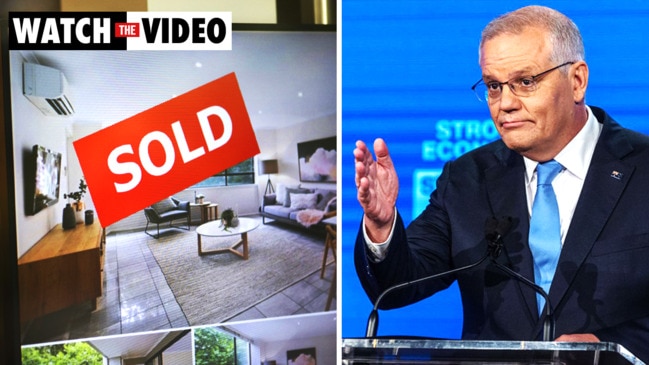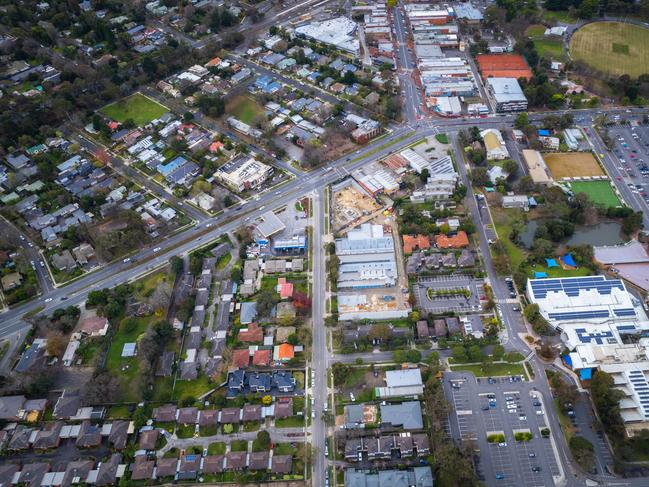‘Biggest problem’ first homebuyer schemes ignore
Labor and the Coalition have now unveiled their proposals to help first homebuyers crack the market — but there’s one glaring issue both parties completely ignore.

Federal Election
Don't miss out on the headlines from Federal Election. Followed categories will be added to My News.
Scott Morrison wants to raid your super. Anthony Albanese wants to share a house with you.
Both major parties have now unveiled their proposals to help first homebuyers crack the market — so whose is best?
On Sunday, the Prime Minister announced the Coalition would allow first homebuyers to unlock their superannuation to buy a house.
Under the plan, workers will be able to withdraw up to 40 per cent of their super to a maximum of $50,000, but must have also saved five per cent of their deposit and live in the property for at least 12 months.
The last-ditch election pitch comes after Labor earlier this month announced its “Help to Buy” scheme, which would see the government assist low-income Australians by taking an equity stake of up to 40 per cent in a property.
The homebuyer will need to have a deposit of two per cent and qualify for a standard home loan with a participating lender to finance the remainder of the purchase. The owner would then be able to buy out the government’s stake.
The competing proposals would be in addition to the government’s existing policies that Labor supports – the five per cent deposit Home Guarantee Scheme, the Family Home Guarantee which helps single parents buy with as little as a two per cent deposit, and the Regional Home Guarantee.
Compare Money's first home buyers guide could help you understand the first home guarantee >

‘Worst policy in 25 years’
Economist Saul Eslake described the Coalition’s superannuation announcement as “a contender for the title of worst housing policy decision in the last 25 years”.
“Although it’s probably not as bad as the reduction in capital gains tax in 1999 or the extension of first homeowner grants to purchasers of established dwellings by the Howard government in 2000,” he said.
“We now have almost 60 years of what I think is incontrovertible evidence which shows that anything that allows Australians to spend more on housing than they otherwise would — first homeowner grants, stamp duty concessions, mortgage guarantees, shared equity schemes, lower interest rates — results in more expensive housing, not more people owning housing.”
Mr Eslake said for all the “crocodile tears” shed about the difficulties faced by aspiring first homebuyers, politicians of all persuasions “keep doing things that make it tougher for them” by pushing policies that continue to drive up house prices.
The reason? Simple numbers.
“Forgive the cynicism, but the political reality is that in any given year, there are only about 100,000 people who succeed in becoming first homebuyers,” he said.
“Assuming four or five fail for every one, that’s maybe 400,000 to 500,000 voters who would favour policies that restrain property price inflation. But at any given time there are at least 11 million people who own their own home, and within that there are two million who own at least more than one property.”
Mr Eslake said Labor’s shared equity scheme “also allows people to spend more on housing than they otherwise would, albeit they have to share the gains with the government when they sell”.
“One’s bad and one’s worse,” he said.
“At least Labor’s scheme has three [limiting] design features. One, only 10,000 people are allowed, which is one tenth of the first homebuyers [in a given year]. Two, there’s an income limit on applications. And three, there’s a ceiling on the value of the property.”
But Mr Eslake said even so, Labor’s policy “will have an impact” on house prices.

‘Have your cake and eat it’
Steve Mickenbecker from financial comparison site Canstar “totally” agreed neither party appeared serious about addressing the elephant in the room.
But he didn’t think either policy would have a significant impact on house prices.
“Help to Buy is only available to 10,000 places a year, and 50,000 places with the Coalition policy — it’s sort of a drop in the bucket,” he said. “Will it move house prices up? I don’t think so, to be honest. I don’t think it reaches enough people to do that.”
Mr Mickenbecker was generally positive about the two proposals.
He argued the Coalition’s idea to tap into superannuation was designed in a way that meant “you can have your cake and eat it”.
“My view is we have got to do something with super, the reason is people have locked away money from the time they turn 20 until they’re 65, but the big need they have is to get into that first home,” he said.
“A real determinant of good standard of living in retirement is getting into your house and getting it paid off — this helps with that.”
Mr Mickenbecker said while some would argue it would diminish long-term retirement savings, the Coalition is “putting in safeguards to deal with that”.
“When you sell your first home to upgrade, you have to recontribute your cash [into superannuation], so effectively you’ve eaten your cake because you can buy your house earlier, but you still have the cake because you’ve made money on the contribution, pulled it out and recontributed it.”
He added, “Will you earn as much as the super fund would have? Who knows, but they’ve got the choice.”

‘These are nice little Band-Aids’
Mr Mickenbecker also praised Labor’s plan as solving a key issue with existing schemes.
“The reason I like it is the first home grant program saddles people with very high debt,” he said.
“You can borrow 95 per cent of the property, a single parent 98 per cent — if you’re a single parent, how can you afford payments on a loan that big? Help to Buy doesn’t because you share the debt with the government. You’ll have less capital gain but at least [it’s more affordable].”
The existing schemes only address the deposit gap, which is a “problem for affordability down the track” due to large loan sizes and rising interest rates.
“Help to Buy addresses both the deposit gap and the affordability gap,” he said.
“They’re finally addressing these issues — [but] what neither party is addressing is house price appreciation, that’s the biggest problem. The underlying issue is house prices have gone up so quickly, way ahead of wages, that the affordability gap gets bigger for people.”
He added, “These are nice little Band-Aids to put on, that do provide some financial help to get into the property market.”
Economist Stephen Koukoulas wrote on Twitter: “If nothing else, the Coalition’s misguided super for housing policy has further highlighted how supply – build lots more houses – and demand – low immigration – are the only sustainable ways to make housing even more affordable. Nothing else matters much.”

Housing affordability crisis
Australia has been gripped by a housing affordability crisis since the early 2000s.
According to the Demographia International Housing Affordability 2022 survey released in March, Sydney is the world’s second-least affordable place to buy a home, while Melbourne is the fifth-worst.
That came after a report last November found first homebuyers in Australia need more than 10 years just to save a home deposit.
The ANZ CoreLogic Housing Affordability report estimated that based on households saving 15 per cent of their gross annual income, it would take the typical Aussie household a record 10.8 years to save a 20 per cent deposit for a house.
Nationally, housing values posted a 21.6 per cent rise over the year ending October 2021, driven by record low mortgage rates, a substantial lift in household savings, a variety of stimulus from governments and improving consumer sentiment as Covid-19 lockdowns lifted.
However, most economists are now warning of a sharp fall in house prices over the next few years, after the Reserve Bank this month raised the official cash rate for the first time in 11 years and warning signs grow in Australia’s troubled construction industry.
HSBC has revised its 2023 housing price forecast from 1 to 4 per cent growth to a fall of 5 to 10 per cent.
“The pace of housing price growth has slowed recently though, such that housing prices are up by only 1 per cent since the beginning of 2022, after a gain of 21 per cent,” HSBC chief economist Paul Bloxham said earlier this month. “The Sydney and Melbourne housing markets have stalled since the beginning of the year.”
AMP Capital chief economist Dr Shane Oliver is tipping a 10 to 15 per cent top-to-bottom fall in prices from mid-year into 2024.
— with NCA NewsWire
Originally published as ‘Biggest problem’ first homebuyer schemes ignore





